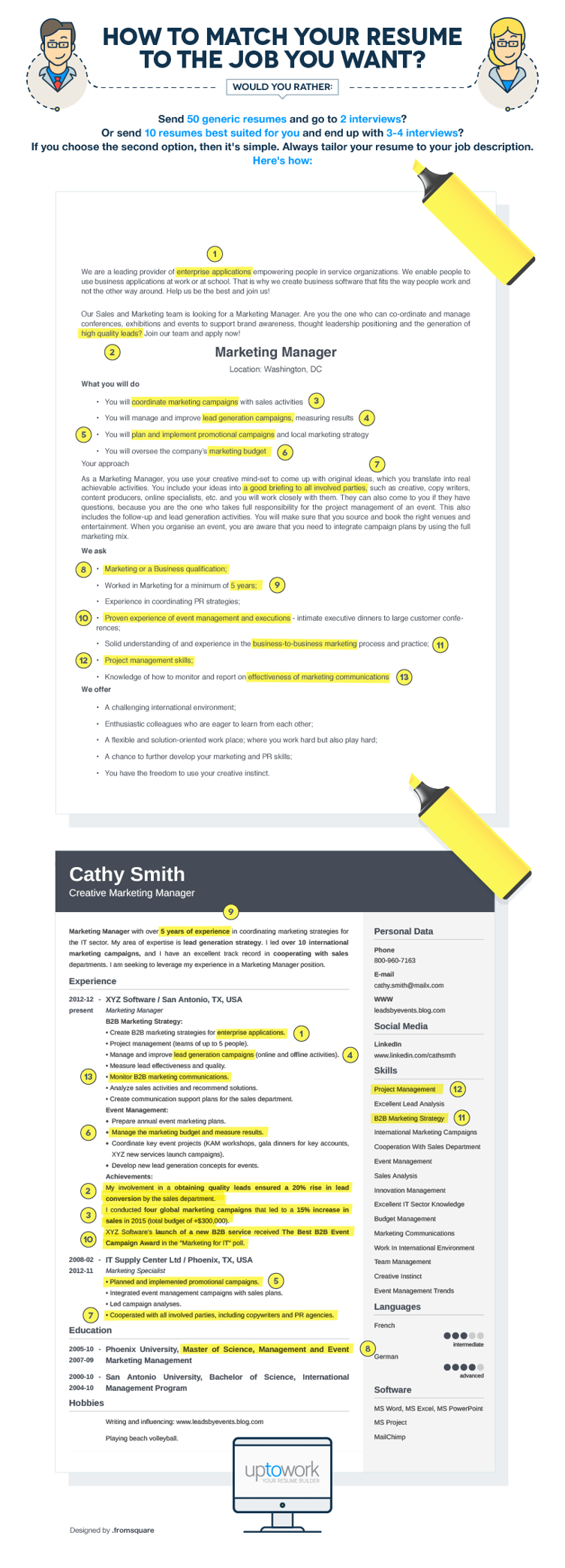 Sure, personalizing your resume is about signaling your enthusiasm for the job. But, it’s also one of the best ways to secure your resume gets seen.
Sure, personalizing your resume is about signaling your enthusiasm for the job. But, it’s also one of the best ways to secure your resume gets seen.
If you think that job postings are just corporate mumbo-jumbo that someone just copy-pasted above and below the name of the position advertised, you’re going to be sadly mistaken.
Deciphering job postings is an essential part of the job application process. Even the worst job descriptions can be useful in customizing your resume for a specific position; if you can read between the lines.
No matter if you’re a recent graduate looking for your first job or a seasoned worker seeking contract employment, you have to do all of the following:
- Read the job posting thoroughly
- Highlight words and phrases describing traits, skills, and experience
- Check how you compare
- Refer to those skill keywords while writing your tailored resume
Next, you'll want to tailor your resume to the employer’s needs. And no, that doesn't mean sneaking in their company name into the objectives section or using a few keywords from the posting. To do this right, you'll want to ensure your resume accomplishes all of the items below.
- Highlight your relevant experience and skills
- Make sure the ATS algorithm doesn’t reject you from the get-go
- Show that you’ve put in the work to research the company and read the job posting carefully
How to Tailor Your Resume to the Job Posting
Because there's a lot to unpack when it comes to writing a tailored resume, so here’s a useful infographic. It will explain how to tailor your resume to the job ad, pass the robot sniff test, and assure the recruiters you are the one for the job.

Tailored Resume Examples
Selecting the Right Skills
Whenever you explain what you did in a previous job, make sure you reference skills you used. Focus on those which are relevant to the job you are now applying for.
Give your skills a plug in the work experience section. Mind you, treat it as you would olive oil — just a drizzle, don’t smother each job position in synonyms and cliches. Don’t just copy keywords from your list over and over again.
How to List Proficiencies
Recruiters don’t read each and every resume. They outsource this task to a special piece of software — the Applicant Tracking System. What ATS software does is scan vast numbers of resumes and rejects any that don’t match specific employability criteria.
If you don’t use the right phrases, your resume will be indistinguishable from a blank sheet of paper. For example, if you’re writing up your MS Excel skills, you should explain what exactly it is that you can do.
Right:
Proficient in MS Excel (macros, pivot tables, data visualization)
Wrong:
MS Excel
Being specific will make those pesky ATS bots warm up to you. It will also help recruiters gauge your abilities.
Documenting Job History
When tailoring your resume, you want to list previously held jobs that are relevant to the position you’re applying for. If you’re a seasoned employee with years in the industry, it’s pointless to mention that you’ve been a restaurant server back in ‘99.
Sounds like too much hassle? Well, you can either spend a few minutes polishing your resume and tailoring it to the job description or keep sending sub-par resumes that get you nowhere for months.
About the Author: Bart Turczynski is a content creator, writer, and editor at Uptowork - a popular career advice website



